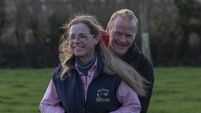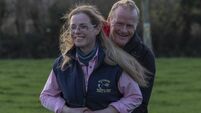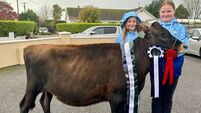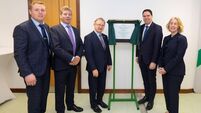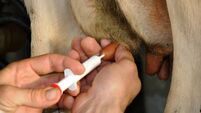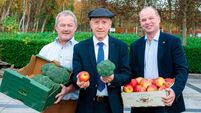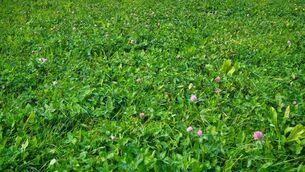Paula Hynes: Tough decisions and why less is more
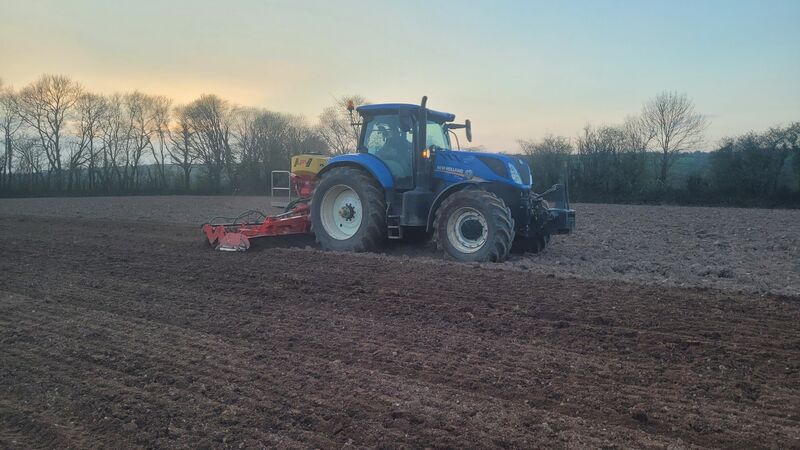
Peter Riordan setting grass seed on the Hynes farm this week
After what has been another week of glorious sunshine, we had 5mm of rain on Friday night, which was very welcome as the forecast for the week ahead is superb again.
Cantys were in ploughing 17 acres this week, seven acres of which is a reseed. With ground conditions perfect, they set the grass seed on Saturday evening.
We went with a high clover, intensive grazing mix which includes Astonenergy. We have always found this tetraploid grazes out extremely well; even if grass covers get a little high, cows will still achieve a good residual. The seeding rate was 13kg/ac and the paddock received farmyard manure prior to ploughing and then 18-6-12 prior to setting. P and K are crucial for reseeds to help promote tillering and also help clover establishment.
The paddock will be rolled and the gate closed. Rain is due in a week's time, so it should germinate well, and the plan going forward will be to graze with the cows in roughly six weeks' time once the grass passes the pull test.
We always prefer to graze reseeds with the cows, they’ll graze it of fast and most likely it will be grazed every 12 to 14 days after that to allow light down to the clover I met so many people this week who were enquiring about Becky and wishing her a speedy recovery and she is very grateful for all the well wishes. She has been down the farm to say hi to the heifers and grab a little fresh air, but work duties are a little way off yet.
This year, we calved all our heifers in early January, which was three weeks before the cows started calving, and it worked out very well for us. I feel the heifers had less competition for the feed rail and milking parlour when they calved and certainly settled into the milking routine easier and quicker.
They also seem to have peaked higher in milk and are in superb body condition ahead of the looming breeding season. Given that it worked out so well for us, we have already served all our maiden heifers this season, and it coincided with the settled weather, which hopefully should improve conception rates further. All heifers received sexed semen and we are also using sexed semen on some of the cows again this year.
We only breed proven cows to sexed semen, cows with proven fertility and whom have also proven themselves in the milking parlour, cows that can deliver high kgs of milk solids with high percentage constituents such as 1373 who was served two days ago. She produces up to 8,000L with fat at over 5% and protein at nearly 4% and an SCC of 31,000 last year.
On her seven th lactation, she calved to sexed this spring, and her dam completed 12 lactations. Although the herd is showing plenty of heats every day, we won’t begin serving big volumes of cows for another three weeks. We see a huge difference in the heifer calves born in January versus the later-born heifer calves, so the aim is to have all replacements born in January.
We have sold all surplus heifer calves now, although we didn’t have many surplus which was planned, we gave Martin first refusal on the heifer calves we were selling. He has been buying heifer calves from us for a few years now, and it is always good to have returning customers knowing the heifers go directly to other farms.
I can safely say this is the best group of heifer calves we have bred to date, so hopefully, they will go on to make great cows for Martin and repay the investment.
Cows are almost finished the first rotation and grazing second rotation paddocks by night, which has really driven protein up with cows producing over 3.5% protein and averaging 30L a day.
I still find myself at the stage where I’m pinching myself a little, the goal was to reduce the herd 18 months ago but gain efficiency and produce the same amount of milk with a smaller herd, it was a brave decision but one that has paid off as we have reached our goal and if cows keep producing they way they have for the first three months, it could be a record production year for us.
In 2015, the drive was to milk as many cows as possible, a golden era for Irish dairy lay ahead, but that golden era got bulldozed on many occasions by low milk prices, droughts, wet autumns and even wetter springs followed on by the fact that we are a little older now and while we still work hard, quality of life is even more crucial.
A decade on from quota removal, it turns out that at times, less is more, but even more importantly, less is actually less stress and ultimately easier to adapt with in times of challenging weather.
As we set our goal 18 months ago, in many ways we also considered farm succession, we’re not ready to hang up the wellies yet but it was crucial we consider a dairy herd that the girls would like to farm in the future, we strived to breed high EBI cows which we have achieved, but now we have married that with also breeding elite high production cows.
We fast-tracked how we wish to breed high-production cows by investing in top-class cow families, all of which are bred to sexed semen so as we focus on growing that small group of cow families into a herd. Likewise, the Jersey herd has improved dramatically in a short space of time, and we are at the stage where we will be offering many well-bred Jersey heifers for sale.
